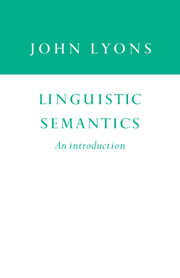Book contents
- Frontmatter
- Contents
- Preface
- List of symbols and typographical conventions
- Part 1 Setting the scene
- Part 2 Lexical meaning
- 2 Words as meaningful units
- 3 Defining the meaning of words
- 4 The structural approach
- Part 3 Sentence-meaning
- Part 4 Utterance-meaning
- Suggestions for further reading
- Bibliography
- Index
4 - The structural approach
Published online by Cambridge University Press: 05 June 2012
- Frontmatter
- Contents
- Preface
- List of symbols and typographical conventions
- Part 1 Setting the scene
- Part 2 Lexical meaning
- 2 Words as meaningful units
- 3 Defining the meaning of words
- 4 The structural approach
- Part 3 Sentence-meaning
- Part 4 Utterance-meaning
- Suggestions for further reading
- Bibliography
- Index
Summary
INTRODUCTION
As we saw in the last chapter, words cannot be defined independently of other words that are (semantically) related to them and delimit their sense. Looked at from a semantic point of view, the lexical structure of a language – the structure of its vocabulary – can be regarded as a network of sense-relations: it is like a web in which each strand is one such relation and each knot in the web is a different lexeme.
The key-terms here are ‘structure’ and ‘relation’, each of which, in the present context, presupposes and defines the other. It is the word ‘structure’ (via the corresponding adjective ‘structural’) that has provided the label – ‘structuralism’ – which distinguishes modern from pre-modern linguistics. There have been, and are, many schools of structural linguistics; and some of them, until recently, have not been very much concerned with semantics. Nowadays, however, structural semantics (and more especially structural lexical semantics) is as well established everywhere as structural phonology and structural morphology long have been. But what is structural semantics? That is the question we take up in the following section.
We shall then move on to discuss two approaches to the task of describing the semantic structure of the vocabularies of languages in a precise and systematic way: componential analysis and the use of meaning-postulates. Reference will also be made, though briefly, to the theory of semantic fields (or lexical fields).
- Type
- Chapter
- Information
- Linguistic SemanticsAn Introduction, pp. 102 - 130Publisher: Cambridge University PressPrint publication year: 1995

